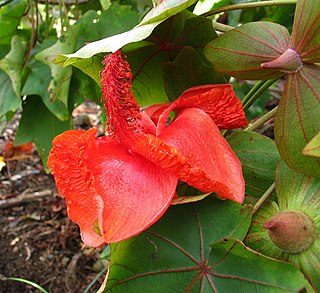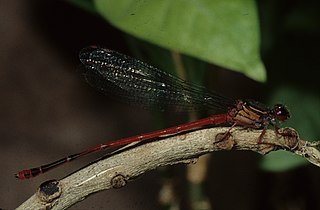
The macaques constitute a genus (Macaca) of gregarious Old World monkeys of the subfamily Cercopithecinae. The 23 species of macaques inhabit ranges throughout Asia, North Africa, and Europe. Macaques are principally frugivorous, although their diet also includes seeds, leaves, flowers, and tree bark. Some species such as the long-tailed macaque will supplement their diets with small amounts of meat from shellfish, insects, and small mammals. On average, a southern pig-tailed macaque in Malaysia eats about 70 large rats each year. All macaque social groups are arranged around dominant matriarchs.

Megalagrion is a genus of damselflies in the family Coenagrionidae. It contains approximately 26 species, all of which are endemic to Hawaiʻi. Megalagrion damselflies are the only native damselflies in Hawaiʻi, and are referred to as "pinapinao" in ʻ ʻŌlelo Hawaiʻi. Other endemic Hawaiian Odonata are the dragonflies Anax strenuus and Nesogonia blackburni, which are referred to as "pinao".

The giant Hawaiian darner, also known as the giant Hawaiian dragonfly or pinao, is a species of dragonfly in the family Aeshnidae. It is one of two species of dragonfly that is endemic to the Hawaiian Islands. It is found near streams and wetlands on all islands of the archipelago and it has a wide altitude range, but is particularly common at higher elevations.
A near-threatened species is a species which has been categorized as "Near Threatened" (NT) by the International Union for Conservation of Nature (IUCN) as that may be vulnerable to endangerment in the near future, but it does not currently qualify for the threatened status.

Kokia drynarioides, commonly known as Hawaiian tree cotton, is a species of flowering plant in the mallow family, Malvaceae, that is endemic to the Big Island of Hawaii. It inhabits dry forests at elevations of 455–1,915 m (1,493–6,283 ft). Associated plants include ʻāheahea, ʻaʻaliʻi, hala pepe, wiliwili, uhiuhi, kōlea, ʻaiea, kuluʻī, ʻālaʻa, ʻohe kukuluāeʻo, māmane, and maua. It is threatened by habitat loss and competition with invasive species, such as fountain grass.
Megalagrion adytum is a species of damselfly in the family Coenagrionidae that is endemic to Hawaii. Its natural habitat is swamps.
Megalagrion jugorum is a possibly extinct species of damselfly in the family Coenagrionidae that is endemic to the island of Maui in Hawaii.

Megalagrion leptodemas, commonly referred to as the Crimson Hawaiian damselfly, is one of the rarest and most endangered Megalagrion species that is endemic to the island of Oahu in Hawaii. It is currently labeled as endangered by the ESA and critically endangered on the IUCN Red List. The general biology of Crimson Hawaiian damselflies is similar to other narrow-winged damselflies. Megalagrion leptodemas used to be found in the mountains of Ko’olau and Wai'anae but is now only found in four watersheds in the Ko’olau Mountains. The species is threatened by habitat loss and non-native species. They have limited habitat and small, scattered populations which can affect their future population stability. Conservation efforts for this species should concentrate on both habitat management and control of invasive species.
Megalagrion molokaiense, common name Molokai damselfly, is a species of damselfly in the family Coenagrionidae. It is endemic to Hawaii. Its natural habitat is subtropical or tropical moist montane forests. It is thought that it breeds on dripping wet embankments or in small streams in habitats that lack gambusia.

Megalagrion oceanicum is a species of damselfly in the family Coenagrionidae that is endemic to the island of Oʻahu in Hawaii. It inhabits rivers in the Waiʻanae and Koʻolau ranges. It is threatened by habitat loss.

Zanthoxylum oahuense, commonly known as aʻe or Oʻahu prickly-ash, is a species of flowering plant in the family Rutaceae, that is endemic to the island of Oʻahu in Hawaii. It is a small tree, reaching a height of 5 m (16 ft). Aʻe inhabits mixed mesic and wet forests at elevations of 580–800 m (1,900–2,620 ft). It is threatened by habitat loss.

Chenopodium oahuense is a species of flowering plant in the amaranth family known by the common names aweoweo, alaweo, alaweo huna, aheahea, ahea, ahewahewa, and kahaihai. It is endemic to Hawaii, where it occurs on all of the larger islands except for Kahoolawe. It is also found on Lisianski Island, Laysan, the French Frigate Shoals, Necker Island, and Nihoa.
Encyclopædia Britannica Macropedia.








